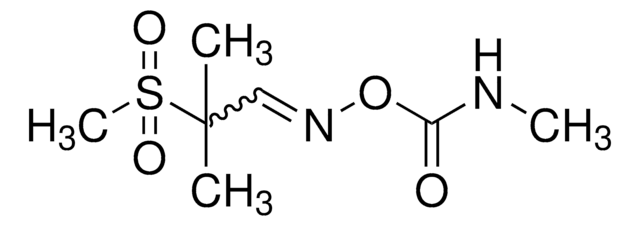CRM69033
Aldicarb-sulfone
mixture of E/Z - isomers, certified reference material, TraceCERT®, Manufactured by: Sigma-Aldrich Production GmbH, Switzerland
About This Item
Polecane produkty
klasa czystości
certified reference material
TraceCERT®
Poziom jakości
linia produktu
TraceCERT®
okres trwałości
limited shelf life, expiry date on the label
producent / nazwa handlowa
Manufactured by: Sigma-Aldrich Production GmbH, Switzerland
temp. przechowywania
2-8°C
ciąg SMILES
CNC(ON=CC(C)(C)S(C)(=O)=O)=O
InChI
1S/C7H14N2O4S/c1-7(2,14(4,11)12)5-9-13-6(10)8-3/h5H,1-4H3,(H,8,10)
Klucz InChI
YRRKLBAKDXSTNC-UHFFFAOYSA-N
Szukasz podobnych produktów? Odwiedź Przewodnik dotyczący porównywania produktów
Powiązane kategorie
Opis ogólny
Certified content by quantitative NMR incl. uncertainty and expiry date are given on the certificate.
Download your certificate at: http://www.sigma-aldrich.com
Aldicarb-sulfone is a metabolite of the systemic carbamate pesticide- aldicarb, used widely against insects, nematodes, and mites for a variety of crops such as citrus fruits, cotton, sugar beet, pecan, and peanut crops.
The parent compound aldicarb (measured inclusive of its sulfoxide and its sulfone) is not approved for its use in the European Union (EU) as a plant protection agent. This is in accordance with Regulation (EC) No 1107/2009 of the European Parliament and repealing Council Directives 79/117/EEC and 91/414/EEC. But a default maximum residue limit (MRL) of 0.02 mg/kg and 0.05 mg/kg is set for the presence of aldicarb in fresh/frozen fruits and tree nuts respectively as per Reg. (EU) No 310/2011.
Zastosowanie
The aldicarb-sulfone CRM may also find given below uses:
- Study of aldicarb and its oxidation degradation products using high-performance liquid chromatography coupled to mass spectrometric and UV detection
- Simultaneous multi-residue analysis of 36 pesticides in spinach and cauliflower samples using multi-walled carbon nanotubes (MWCNTs) as an adsorbent for the reversed-dispersive solid-phase extraction (r-DSPE) and liquid chromatography-tandem mass spectrometry (LC-MS/MS) for the identification and quantification
- Analysis of 102 pesticide residues in green tea samples using a modified QuEChERS method combined to high-performance liquid chromatography-tandem mass spectrometry (HPLC-MS/MS)
- Development and validation of a method for determination of 58 pesticides and their metabolite residues in egg samples by a multi-functional filter (MFF) based QuEChERS clean-up and ultra-high performance liquid chromatography-tandem mass spectrometric (UHPLC-MS/MS) analysis
- Evaluation of different adsorbents to clean-up edible oil samples of sunflower, olive, and soya for the simultaneous analysis of oil samples for 169 pesticides by ultra high-performance liquid chromatography-triple quadrupole mass spectrometry (UHPLC-QqQ-MS/MS)
- Method development for analyzing 34 pesticide residues from 9 different classes of chemical compounds in human serum samples using salt-assisted acetonitrile extraction and high-performance liquid chromatography-quadrupole time of flight-tandem mass spectrometric (HPLC-QTOF-MS) quantification
Polecane produkty
Informacje prawne
Hasło ostrzegawcze
Danger
Zwroty wskazujące rodzaj zagrożenia
Zwroty wskazujące środki ostrożności
Klasyfikacja zagrożeń
Acute Tox. 2 Dermal - Acute Tox. 2 Inhalation - Acute Tox. 2 Oral - Aquatic Acute 1
Kod klasy składowania
6.1A - Combustible acute toxic Cat. 1 and 2 / very toxic hazardous materials
Klasa zagrożenia wodnego (WGK)
WGK 3
Temperatura zapłonu (°F)
Not applicable
Temperatura zapłonu (°C)
Not applicable
Choose from one of the most recent versions:
Certyfikaty analizy (CoA)
Don't see the Right Version?
If you require a particular version, you can look up a specific certificate by the Lot or Batch number.
Masz już ten produkt?
Dokumenty związane z niedawno zakupionymi produktami zostały zamieszczone w Bibliotece dokumentów.
Nasz zespół naukowców ma doświadczenie we wszystkich obszarach badań, w tym w naukach przyrodniczych, materiałoznawstwie, syntezie chemicznej, chromatografii, analityce i wielu innych dziedzinach.
Skontaktuj się z zespołem ds. pomocy technicznej









